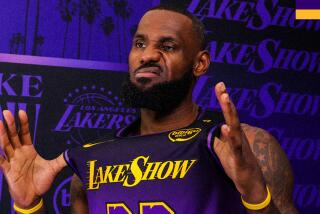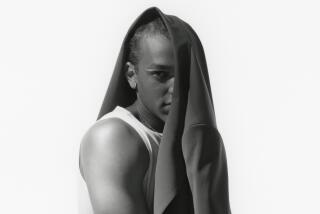MVPs off the court
- Share via
In 2010, a month before he took to the basketball court for the first time in a New York Knicks uniform, Amare Stoudemire took to the red carpet at Lincoln Center in head-to-toe Tom Ford. In 2009, when NBA No. 1 draft pick Blake Griffin was chosen by the Clippers, he was wearing a custom suit, a purple necktie and eye-catching pocket square from L.A. tailor Waraire Boswell. And sometime during this year’s playoffs, there’s a decent chance the Miami Heat’s Dwyane Wade will be photographed sporting a diamond lapel pin from Jason of Beverly Hills.
The National Basketball Assn. has had its share of style-savvy players — and even coaches (paging Pat Riley). But it wasn’t so long ago that the biggest fashion statement on court or off was Dennis Rodman dying his hair the colors of a fruit bowl and Shaquille O’Neal wearing baggy suits — definitely a mixed bag.
Think about it: It can be hard to find the right clothes when you’re somewhere around the NBA average of 6 foot 7.
But today — witness Stoudemire, Griffin and Wade — even the tallest players sport a trim and tailored look. Having a personal stylist is de rigueur. Nattily attired, high-profile players grace the covers of glossy style magazines and sit front row at fashion shows next to Vogue’s Anna Wintour.
The athletes’ fashion side projects and brand endorsements have become so common that the league’s acronym might as well be “National Bespoke Assn.” And it’s not just about court shoes anymore. The Celtics’ Jermaine O’Neal recently launched a menswear label dubbed Le Jaunty. Stoudemire is collaborating with designer Rachel Roy on a collection for women (spotlighted by Women’s Wear Daily last week). And the Lakers’ Kobe Bryant has partnered with Nubeo on a line of ungodly expensive watches.
It’s hard to reconcile the wardrobe of today’s hardwood warriors with the laissez-faire look of the league circa 2005, when the NBA felt compelled to institute an official dress code.
“The dress code was part of a larger discussion about the business of basketball, the players’ role in it and projecting a positive image,” said Michael Bantom, senior vice president of player development for the NBA. “It was something that teams had dealt with on an individual basis. Some teams had their own dress codes, others didn’t.”
But as of the 2005-06 season, off-court players engaged in team or league business were required to wear collared dress shirts or turtlenecks, dress slacks, khakis or dress jeans with “appropriate shoes and socks.” Players at games but not in uniform were additionally required to wear a sport coat, dress socks and dress shoes or boots. T-shirts, sports jerseys, shorts, headphones, sunglasses worn indoors or headgear of any kind were prohibited while a player was on team or league business.
Many observers — including Bantom — see that as the first ripple in what would eventually become a change in the way professional basketball players approached their clothing choices.
“True to their competitive nature, once they started dressing up — and seeing how good they looked — they started competing with each other to see who could dress the best,” Bantom said. “The evidence of that can be seen in their interest in fashion and the exposure they’re now getting because of the way they’re dressing.”
That meant players were no longer simply satisfied with the convenience of one-stop custom clothiers such as Élevée in Van Nuys, which in 2005 laid claim to half of the NBA’s players as clients. Stephon Marbury once placed an order for 82 suits — one for each regular season game — and longtime customer Shaquille O’Neal was known to order 52 shirts and 20 pairs of trousers at a clip.
But after the dress code was implemented, some pro ballers took a page from the music and movie industry celebrity playbook and began to engage the services of personal stylists.
“Before the league changed the rules, it was pretty simple,” said Paige Geran, a stylist who has worked with Kobe Bryant for the last year and a half. “The guys would just wear suits for every game so they’d just buy them in bulk.”
After the rule change, “the more savvy guys — the Kobes, the LeBrons [James] and the D-Wades — they started turning to stylists because they enjoy fashion and wanted to look a little more unique. A stylist can bring a lot to the table for them — they’re getting to wear stuff that a man who is 6 foot 3 can wear.”
Geran’s comment underscores a crucial point: buying off-the-rack clothes — especially dress shirts and tailored suits — isn’t an option for most players. And when a guy’s workaday uniform is, in fact, a uniform, there is all the more reason to kick things up a notch.
The sartorial sea change led to recognition not only in men’s style bibles GQ and Esquire, but also in sports media. ESPN the Magazine’s first dedicated fashion issue hit newsstands in March with the Chicago Bulls’ Derrick Rose on the cover. The month before, Sports Illustrated published the results of a poll of 137 NBA players, asking which of their basketball brethren had the best fashion sense off the court. The Miami Heat’s Wade took top honors as an all-star of style, followed by Bryant in second place and Wade’s teammate James in third. Fifteen players made the list, including New York’s Carmelo Anthony in fifth, Stoudemire (13th), and Laker Derek Fisher (14th).
Wade is a “Gucci-Ralph Lauren guy,” says L.A.-based stylist Calyann Barnett, who has worked with Wade since 2007 and recently added Laker Lamar Odom to her roster. “Those companies make shoes, jackets and sweaters that will fit him right off the rack.”
Bryant gets everything custom made, according to his stylist, Geran. “I’ve even got some companies that don’t do made-to-measure but will do it for him,” she says.
Bryant’s body lends itself to the suit silhouette. “He has broad shoulders and a narrow chest — kind of a runway look,” Geran explains. Made-to-measure Giorgio Armani and Dolce & Gabbana are current favorites. For custom dress shirts, Geran swears by Anto of Beverly Hills; for knits, she turns to John Varvatos; and for dress shoes, it’s Gucci and Louis Vuitton.
Both stylists point out that custom-made George Esquivel shoes and Tom Ford suits and accessories have found favor throughout the league.
Just as with other celebrities, sometimes designer merchandise is made available to the athletes for free, for the publicity value when a high-profile player is seen at a major event. But “it really would depend on the athlete and what he is attending, just like a celebrity,” Geran said. “In my opinion, most of the stuff that people are trying to give for free are things I don’t want. A lot of the free stuff that people supposedly get is a myth to me. It’s not a ton of ‘good’ stuff. It’s things here and there. Discounts, yes. Good free stuff, not really.”
Although the regular season is over, that doesn’t mean anyone is slacking off in the style stakes. The playoffs are the Oscars red-carpet season of pro basketball. With fewer teams, higher-profile games and more postgame interviews, wardrobe scrutiny is more intense than ever — which is why Wade has some surprises up his custom-made sleeve.
“We’re going with even more colorful pocket squares, and we’ve shortened his pants hem, so look for tons and tons of colorful socks — and suspenders,” Barnett says. “And he started wearing this diamond lapel pin made by Jason of Beverly Hills, so you’ll definitely see that.”
A reminder, perhaps, of an even more highly prized Jason of Beverly Hills accessory, one that even the best stylist couldn’t procure — last year’s Lakers NBA Championship ring.







